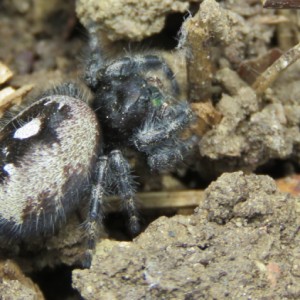Tiny Tuesday: Phidippus Audax
My apologies to the arachnophobes but I've never seen a spider that looks like this and I had to have it in my journal. Pipersdad called me out to where he was moving wood in the yard and said to bring my camera. I'm fairly certain that he is a Daring Jumping Spider. The only thing different is the mostly white back but I couldn't find any spider with a back like this...and I looked at a lot of spiders online. See the extra for a better look at the back. I was thinking about emailing it to the author of the article below for ID....unless someone knows for sure. Thanks to Beckett for hosting on the 1st anniversary of Tiny Tuesday!
By Judy Sedbrook, Colorado Master GardenerSM , Colorado State University Cooperative Extension, Denver
"The Daring Jumping Spider is commonly found in gardens and homes along the Front Range. In the garden they can be found on tree trunks, fallen leaves and in ground debris. Entering homes in search of prey, they are often seen near windowsills and doorjambs.
Daring jumping spiders are large, usually growing to about ¾-inch. Their bodies are stocky, black or brown, and hairy. The abdomen is marked with a white crossband and several grey or white spots. The chelicerae are a noticeable metallic green. The name "Jumping" spider comes from the behavior of the male, who "jumps" during mating if the female approaches too quickly.
These spiders like sunshine and do their hunting during the day. They walk with an irregular gait and leap on their prey. Their excellent eyesight aids them in stalking prey, and their large appetites make them a beneficial resident of the garden. Even though they do not spin webs, jumping spiders can always be seen attached to a line of silk that protects them from falling should they miss their prey. The female uses this silk to make a retreat where she produces her egg sac and tends to it until the spiderlings hatch and disperse.
Although scary looking, these spiders are non-poisonous and are not harmful to humans."


Comments
Sign in or get an account to comment.


